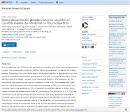| dc.contributor.author | Emma, Panzi Mukhokosi | |
| dc.contributor.author | Maliki, Maaza | |
| dc.contributor.author | Muhammed, Tibenkana | |
| dc.contributor.author | Nandipha, L Botha | |
| dc.contributor.author | Loyce, Namanya | |
| dc.contributor.author | Madiba, I G | |
| dc.contributor.author | Michael, Okullo | |
| dc.date.accessioned | 2023-10-13T07:53:01Z | |
| dc.date.available | 2023-10-13T07:53:01Z | |
| dc.date.issued | 2023-04 | |
| dc.identifier.citation | Mukhokosi, E. P., Maaza, M., Tibenkana, M., Botha, N. L., Namanya, L., Madiba, I. G., & Okullo, M. (2023). Optical absorption and photoluminescence properties of Cucurbita maxima dye adsorption on TiO2 nanoparticles. Materials Research Express, 10(4), 046203. | en_US |
| dc.identifier.uri | DOI 10.1088/2053-1591/acce91 | |
| dc.identifier.uri | https://hdl.handle.net/20.500.12504/1449 | |
| dc.description.abstract | Dye-sensitised solar cells (DSSCs) are 3rd generation photovoltaic device that imitate photosynthesis in plants. The fundamental concept of a DSSCs is that the photoanode is covered by the dye as a sensitiser. Natural dyes from plant-based extracts have gained attention as alternatives to toxic and expensive commercial dye sensitisers. Various studies have been conducted on the use of natural plant dye extracts for DSSCs . However, more fundamental studies on their adsorption on TiO2 photoanode nanoparticles are still not well understood. In this study, we investigated the crystal structure, optical absorption, and photoluminescence properties of TiO2, Cucurbita maxima, and Cucurbita maxima dyes adsorbed on TiO2 nanoparticles as potential materials for DSSCs. Raman spectra confirmed the anatase phase of the TiO2 nanoparticles. The particle size of 12 ± 2 nm was confirmed through the transmission electron microscope. The optical absorption properties of Cucurbita maxima show two distinct absorption bands: blue visible (450–500 nm) and red visible (635–674 nm). The photoluminescence spectra of the dye extract and its adsorption onto the TiO2 nanoparticles showed two prominent peaks in the blue and red regions of the electromagnetic spectrum. No significant peak is observed in the green region of the electromagnetic spectrum. These studies shed more light on the fundamental properties of chlorophyll adsorption on TiO2 nanoparticles and their optical and photoluminescence properties for applications as sensitisers in DSSCs. | en_US |
| dc.language.iso | en | en_US |
| dc.publisher | IOP Publishing Materials Research Express | en_US |
| dc.subject | Dye-sensitised solar cells (DSSCs) | en_US |
| dc.subject | TiO2 photoanode nanoparticles | en_US |
| dc.subject | Raman spectra | en_US |
| dc.subject | Photoluminescence spectra | en_US |
| dc.title | Optical absorption and photoluminescence properties of Cucurbita maxima dye adsorption on TiO2 nanoparticles | en_US |
| dc.type | Article | en_US |

